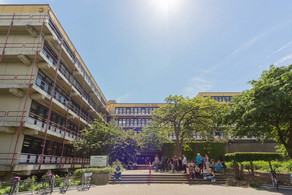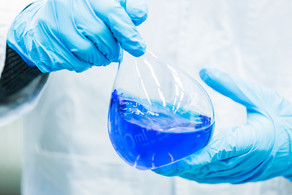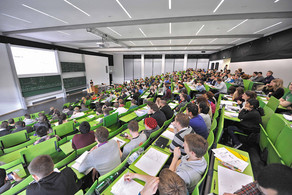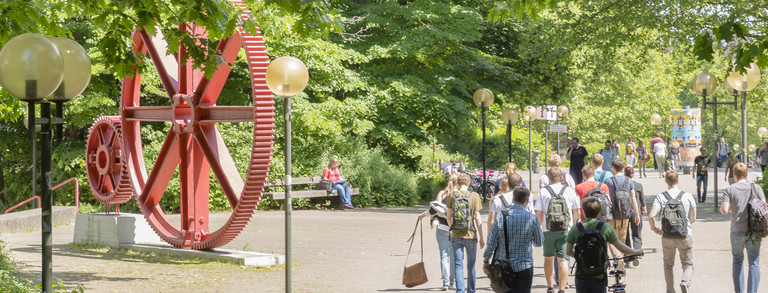Publications
2025
Führer S, Gallant K, Kaschani F, Kaiser M, Janning P, Waldmann H, Gersch M,
"Small Molecule-Induced Alterations of Protein Polyubiquitination Revealed by Mass-Spectrometric Ubiquitome Analysis"
Angew Chem Int Ed 2025, online. doi.org/10.1002/anie.202508916
Kazi NH, Klink N, Gallant K, Kipka GM, Gersch M,
"Chimeric deubiquitinase engineering reveals structural basis for specific inhibition of USP30 and a framework for DUB ligandability“
Preprint
Nat Struct Mol Biol 2025, online. doi.org/10.1038/s41594-025-01534-4
Wendrich K, Gallant K, Recknagel S, Petroulia S, Kazi NH, Hane, JA, Führer S, Bezstarosti K, O’Dea R, Demmers J, Gersch M,
“Discovery and mechanism of K63-linkage-directed deubiquitinase activity in USP53”
Nat Chem Biol 2025, 21, 746–757. doi.org/10.1038/s41589-024-01777-0
2024
Banerjee S, Cakil ZV, Gallant K, van den Boom J, Palei S, Meyer H, Gersch M, Summerer D,
“Light-Activatable Ubiquitin for Studying Linkage-Specific Ubiquitin Chain Formation Kinetics"
Adv Sci 2024, 2406570. doi.org/10.1002/advs.202406570
Hennes E, Lucas B, Scholes NS, Cheng XF, Scott DC, Bischoff M, Reich K, Gasper R, Lucas M, Xu TT, Pulvermacher LM, Dötsch L, Imrichova H, Brause A, Naredla KR, Sievers S, Kumar K, Janning P, Gersch M, Murray PJ, Schulman BA, Winter GE, Ziegler S, Waldmann H,
"Monovalent Pseudo-Natural Product Degraders Supercharge the Native Degradation of IDO1 by KLHDC3“
Preprint: https://www.biorxiv.org/content/10.1101/2024.07.10.602857v1
Keijzer N, Priyanka A, Stijf-Bultsma Y, Fish A, Gersch M, Sixma TK,
“Variety in the USP deubiquitinase catalytic mechanism”
Life Sci Alliance 2024, 7(4), e202302533. doi.org/10.26508/lsa.202302533
Schmidt M, Grethe C, Recknagel S, Kipka GM, Klink N, Gersch M,
"N-Cyanopiperazines as Specific Covalent Inhibitors of the Deubiquitinating Enzyme UCHL1"
Angew. Chem., Int. Ed., 2024, 63, e202318849. doi.org/10.1002/anie.202318849
2023
Zhao Z, O'Dea R, Wendrich K, Kazi N, Gersch M,
"Native semi-synthesis of isopeptide-linked substrates for specificity analysis of deubiquitinases and Ubl proteases“
J Am Chem Soc, 2023, 145(38), 20801–20812. doi.org/10.1021/jacs.3c04062
O’Dea R, Kazi N, Hoffmann-Benito A, Zhao Z, Recknagel S, Wendrich K, Janning P, Gersch M,
"Molecular basis for Ubiquitin/Fubi cross-reactivity in USP16 and USP36"
Nat Chem Biol, 2023, 19(11), 1394–1405. doi.org/10.1038/s41589-023-01388-1
2022
Grethe C, Schmidt M, Kipka GM, O'Dea R, Gallant K, Janning P, Gersch M,
"Structural basis for specific inhibition of the deubiquitinase UCHL1"
Nat Commun., 2022, 13(1), 5950. doi.org/10.1038/s41467-022-33559-4
2021
Ruiz EJ, Pinto-Fernandez A, Turnbull AP, Lan L, Charlton TM, Scott HC, Damianou A, Vere G, Riising EM, Da Costa C, Krajewski WW, Guerin D, Kearns JD, Ioannidis S, Katz M, McKinnon C, O'Connell J, Moncaut N, Rosewell I, Nye E, Jones N, Heride C, Gersch M, Wu M, Dinsmore CJ, Hammonds TR, Kim S, Komander D, Urbe S, Clague MJ, Kessler BM, Behrens A,
"USP28 deletion and small-molecule inhibition destabilizes c-MYC and elicits regression of squamous cell lung carcinoma"
Elife, 2021, 10, e71596. doi.org/10.7554/eLife.71596
2020
Rusilowicz-Jones EV, Jardine J, Kallinos A, Pinto-Fernandez A, Guenther F, Giurrandino M, Barone FG, McCarron K, Burke CJ, Murad A, Martinez A, Marcassa E, Gersch M, Buckmelter AJ, Kayser-Bricker KJ, Lamoliatte F, Gajbhiye A, Davis S, Scott HC, Murphy E, England K, Mortiboys H, Komander D, Trost M, Kessler BM, Ioannidis S, Ahlijanian MK, Urbé S, Clague MJ,
"USP30 sets a trigger threshold for PINK1-PARKIN amplification of mitochondrial ubiquitylation"
Life Sci Alliance ,2020, 3(8), e202000768. doi.org/10.26508/lsa.202000768
2019
Gersch M, Wagstaff JL, Toms AV, Graves B, Freund SMV, Komander D,
“Distinct USP25 and USP28 Oligomerization States Regulate Deubiquitinating
Activity”
Mol Cell, 2019, 74(3), 436–451. doi.org/10.1016/j.molcel.2019.02.030
2018
Stahl M, Korotkov VS, Balogh D, Kick LM, Gersch M, Pahl A, Kielkowski P, Richter K, Schneider S, Sieber SA,
“Selective Activation of Human Caseinolytic Protease P (ClpP)”
Angew Chem Int Ed, 2018, 57(44), 14602-14607. doi.org/10.1002/anie.201808189
2017
Turnbull AP, Ioannidis S, Krajewski WW, Pinto-Fernandez A, Heride C, Martin ACL, Tonkin LM, Townsend EC, Buker SM, Lancia DR, Caravella JA, Toms AV, Charlton TM, Lahdenranta J, Wilker E, Follows BC, Evans NJ, Stead L, Alli C, Zarayskiy VV, Talbot AC, Buckmelter AJ, Wang M, McKinnon CL, Saab F, McGouran JF, Century H, Gersch M, Pittman MS, Marshall CG, Raynham TM, Simcox M, Stewart LMD, McLoughlin SB, Escobedo JA, Bair KW, Dinsmore CJ, Hammonds TR, Kim S, Urbé S, Clague MJ, Kessler BM, Komander D,
“Molecular basis of USP7 inhibition by selective small-molecule inhibitors”
Nature, 2017, 550, 481–486. doi.org/10.1038/nature24451
Gersch M, Gladkova C, Schubert A, Michel M, Maslen S, Komander D,
“Mechanism and regulation of the Lys6-selective deubiquitinase USP30”
Nat Struct Mol Biol, 2017, 24(11), 920–930. (Also highlighted in Nat Chem Biol). doi.org/10.1038/nsmb.3475
Hundshammer C, Düwel S, Köcher S, Gersch M, Feuerecker B, Scheurer C, Haase A, Glaser SJ, Schwaiger M, Schilling F,
“Deuteration of hyperpolarized 13C-labeled zymonic acid enables sensitivity-enhanced dynamic MRI of pH”
ChemPhysChem, 2017, 18, 2422–2425. doi.org/10.1002/cphc.201700779
Düwel S, Hundshammer C, Gersch M, Feuerecker B, Steiger K, Buck A, Walch A, Haase A, Glaser SJ, Schwaiger M, Schilling F,
“Imaging of pH in vivo using hyperpolarized 13C-labelled zymonic acid”
Nat Commun, 2017, 8, 15126. doi.org/10.1038/ncomms15126
Balogh D, Dahmen M, Stahl M, Poreba M, Gersch M, Drag M, Sieber SA,
“Insights into ClpXP proteolysis: heterooligomerization and partial deactivation enhance chaperone affinity and substrate turnover in Listeria monocytogenes”
Chem Sci, 2017, 8, 1592–1600. doi.org/10.1039/C6SC03438A
2016
Mevissen TE, Kulathu Y, Mulder MP, Geurink PP, Maslen SL, Gersch M, Elliott PR, Burke JE, van Tol BD, Akutsu M, El Oualid F, Kawasaki M, Freund SM, Ovaa H, Komander D,
“Molecular basis of Lys11-polyubiquitin specificity in the deubiquitinase Cezanne”
Nature, 2016, 538(7625), 402–405. doi.org/10.1038/nature19836
Gersch M, Stahl M, Poreba M, Dahmen M, Dziedzic A, Drag M, Sieber SA
“Barrel-shaped ClpP proteases display attenuated cleavage specificities”
ACS Chem Biol, 2016, 19(11), 389–399. doi.org/10.1021/acschembio.5b00757
2015
Gersch M, Hackl M, Dubiella C, Dobrinevski A, Groll M, Sieber SA,
“Intact protein mass spectrometry of 20S proteasomes reveals complex integrity, phosphorylation stoichiometry and inhibitor specificity”
Chem Biol, 2015, 22(3), 404–411. doi.org/10.1016/j.chembiol.2015.01.004
Gersch M, Famulla K, Dahmen M, Goebl C, Malik I, Richter K, Korotkov VS, Sass P, Ruebsamen-Schaeff H, Madl T, Broetz-Oesterhelt H, Sieber SA,
“AAA+ chaperones and acyldepsipeptides activate the ClpP protease via conformational control”
Nat Commun, 2015, 19(6), 6320. doi.org/10.1038/ncomms7320
Wauer T, Swatek KN, Wagstaff JL, Gladkova C, Pruneda JN, Michel MA, Gersch M, Johnson CM, Freund SM, Komander D,
“Ubiquitin Ser65 phosphorylation affects ubiquitin structure, chain assembly and hydrolysis”
EMBO J, 2015, 34(3), 307–325. doi.org/10.15252/embj.201489847
2014
Gersch M, Sieber SA,
“Modulation of ClpP Protease Activity: from Antibiotics to Antivirulence”
In: Concepts and Case Studies in Chemical Biology, 2014, Wiley-VCH, Weinheim.
Dubiella C, Cui H, Gersch M, Brouwer A, Sieber SA, Krüger A, Liskamp RM, Groll M,
“Selective immunoproteasome inhibition by ligand-induced active site crosslinking”
Angew Chem Int Ed, 2014, 53(44), 11969–11973. doi.org/10.1002/anie.201406964
Gersch M, Kolb R, Alte F, Groll M, Sieber SA,
"Disruption of oligomerization and dehydroalanine formation as mechanisms for ClpP protease inhibition"
J Am Chem Soc, 2014, 136(4),1360–1366. doi.org/10.1021/ja4082793
Schilling F, Glaser SJ, Düwel S, Gersch M,
“pH-biosensors based on compounds produced from pyruvic acid for magnetic resonance imaging and spectroscopy and their uses”
European patent EP3058375, filed: 15.10.2014, granted: 26.12.2018.
2013
Zeiler E, List A, Alte F, Gersch M, Wachtel R, Poreba M, Drag M, Groll M, Sieber SA,
"Structural and functional insights into caseinolytic proteases reveal an unprecedented regulation principle of their catalytic triad“
Proc Natl Acad Sci USA, 2013, 110(28), 11302–11307. doi.org/10.1073/pnas.1219125110
Gersch M, Gut F, Korotkov V, Lehmann J, Böttcher T, Rusch M, Hedberg C, Waldmann H, Klebe G, Sieber SA,
"The Mechanism of ClpP Inhibition",
Angew Chem Int Ed, 2013, 52(10), 3009–3014. doi.org/10.1002/anie.201204690
2012
Gersch M, Kreuzer J, Sieber SA,
"Electrophilic natural products and their biological targets",
Nat Prod Rep, 2012, 29, 659–682. doi.org/10.1039/C2NP20012K
Gersch M, List A, Groll M, Sieber SA,
"Insights into the structural network responsible for oligomerization and activity of the bacterial virulence regulator caseinolytic protease P (ClpP)"
J Biol Chem, 2012, 287(12), 9484–9494. doi.org/10.1074/jbc.M111.336222
2011
Shen A, Lupardus PJ, Gersch M, Puri AW, Albrow VE, Garcia KC, Bogyo M,
"Defining an allosteric circuit in the cysteine protease domain of Clostridium difficile toxins"
Nat Struct Mol Biol, 2011, 18(3), 364–371. doi.org/10.1038/nsmb.1990
2010
Gersch M, Sieber SA,
"Disarming Clostridium difficile"
Chem Biol, 2010, 17, 1165–1166. doi.org/10.1016/j.chembiol.2010.11.003





